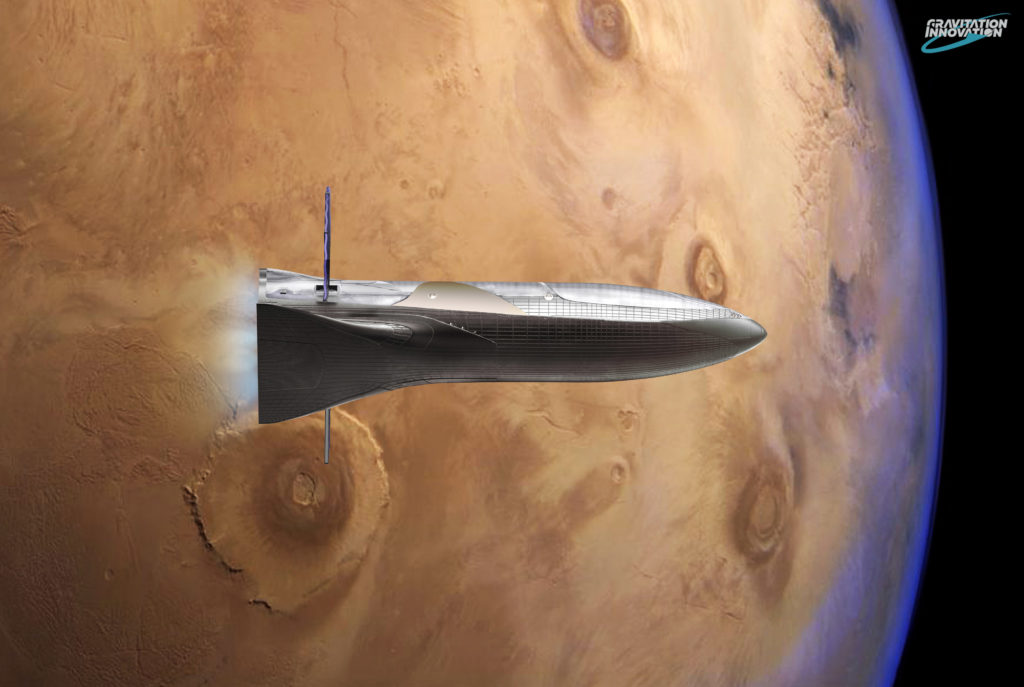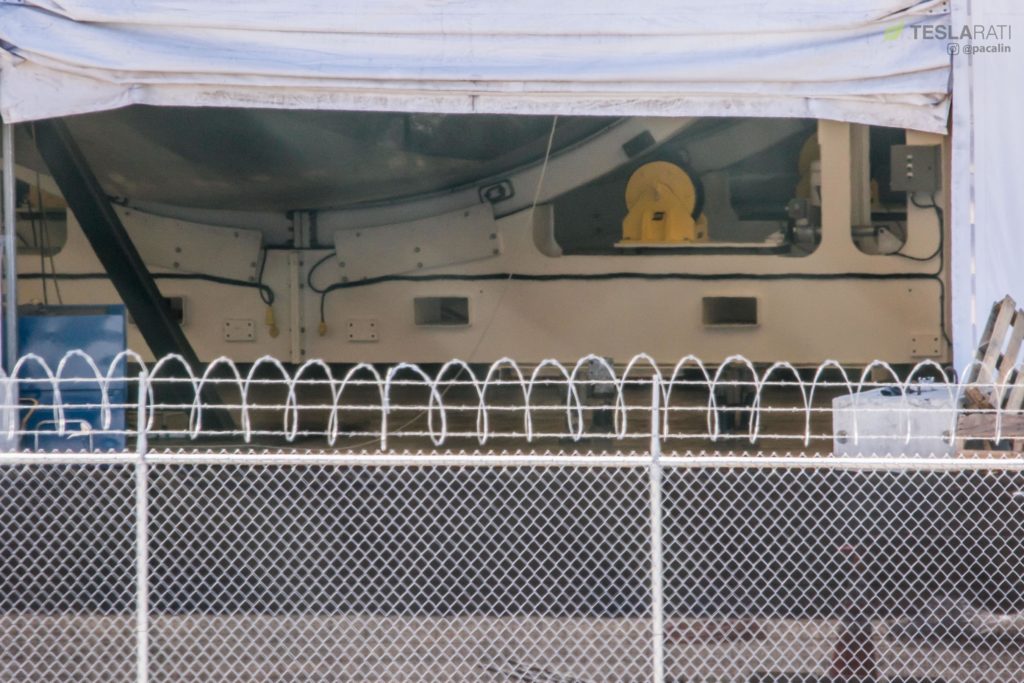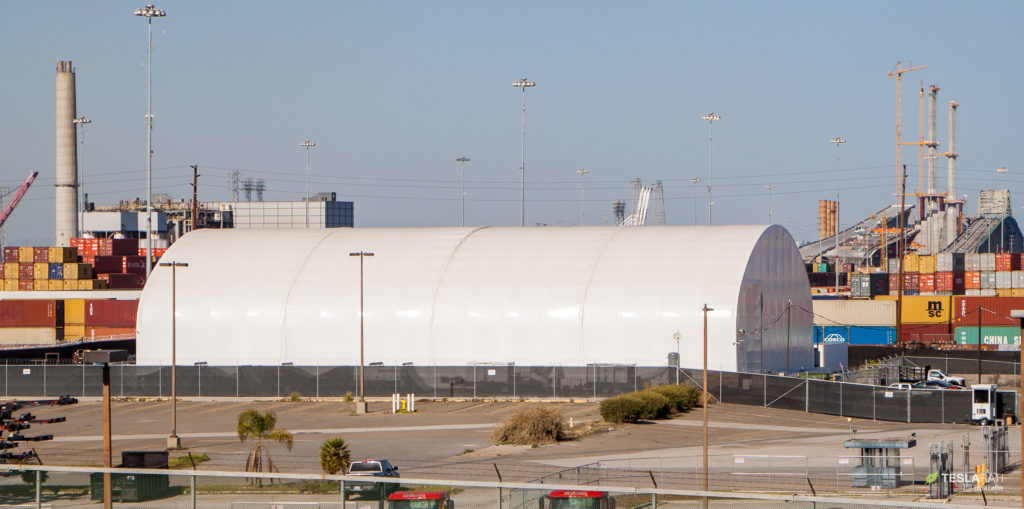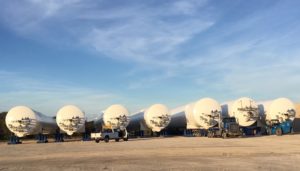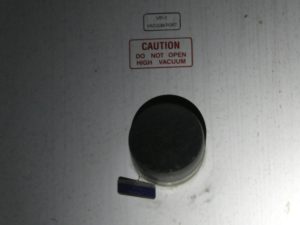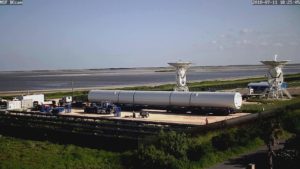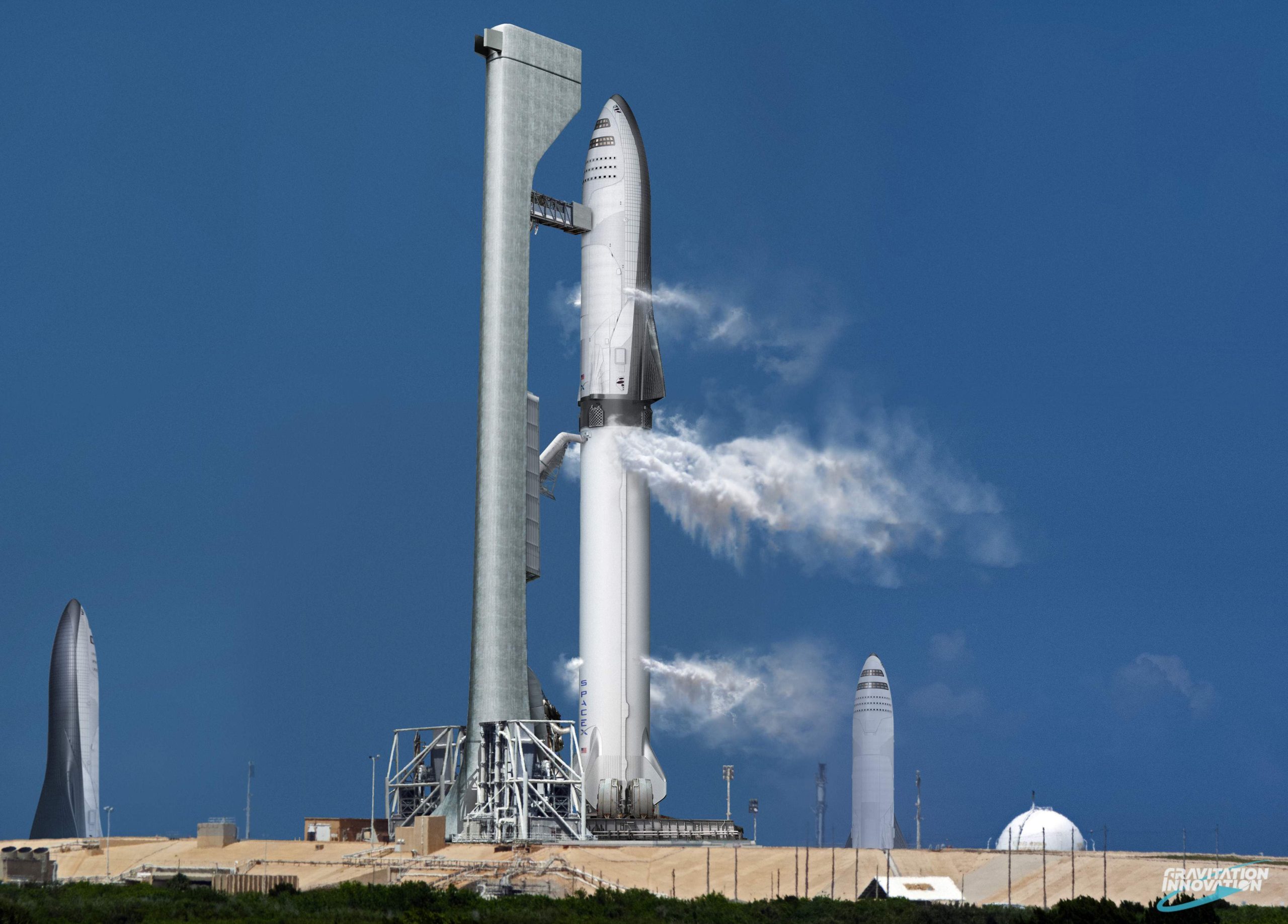
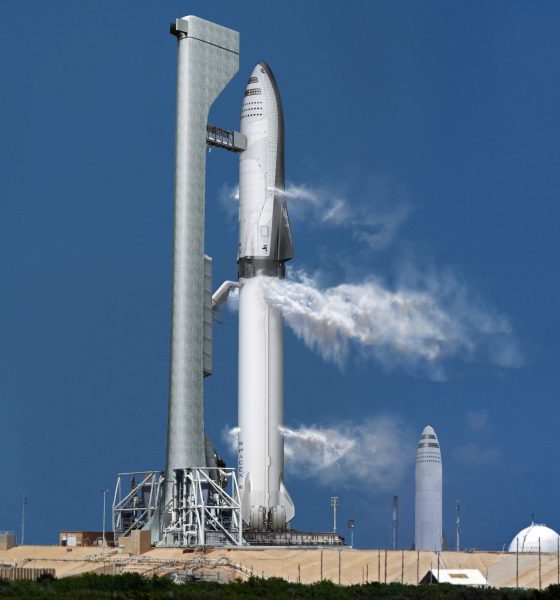
News
SpaceX Mars rocket test site receives first huge rocket propellant storage tank
SpaceX has delivered one of the first undeniably rocketry-related pieces of hardware to its prospective Boca Chica test and launch facility in South Texas, this time in the form of a massive 100,000-gallon liquid oxygen tank now stationed adjacent to the company’s ~600 kW Tesla solar and battery array.
In a statement provided to local paper Valley Morning Star, SpaceX spokesperson Sean Pitt filled in a few of the details and confirmed that the LOX tank had been delivered to Boca Chica as part of an ongoing effort to ready the site for initial testing – and eventually launches – of an unspecified “vehicle”
“Delivery of a new liquid oxygen tank, which will be used to support propellant-loading operations during launch and vehicle tests, represents the latest major piece of launch hardware to arrive at the [South Texas] site for installation.” – SpaceX
The official SpaceX statement may not have explicitly stated that the aforementioned “vehicle” was something other than Falcon 9 or Heavy, but it can be all but guaranteed that the testing and launching described refers to the company’s next-generation Mars rocket, a completely reusable architecture known as BFR.
An immense liquid oxygen (LOX) tank just arrived at @SpaceX's prospective Boca Chica, TX facility, likely to be dedicated to BFR & BFS testing. @NASASpaceflight forum user "Nomadd" caught some of the first detailed photos, as well as the tank's arrival at SpaceX land on July 11. pic.twitter.com/hr7SeA6BGw
— Eric Ralph (@13ericralph31) July 12, 2018
A slow burn in South Texas
Over the past 6-9 months, SpaceX CEO Elon Musk and President/COO Gwynne Shotwell have repeatedly spoken on the subject of SpaceX’s South Texas ambitions, lending unambiguous credence to the idea that the Boca Chica rocket facility will be almost exclusively dedicated to testing BFR’s first flightworthy spaceship prototypes, beginning with a series of familiar suborbital “hops”.
- Artist David Romax’s jaw-dropping rendition of a BFR burning to Mars orbit. The craft’s various curves and hull complexities will likely rely on cutting-edge composite joining tech to function. (Gravitation Innovation)
- SpaceX may well already be fabricating propellant tanks and structural components for the first Mars spaceship prototype in a giant tent at Port of San Pedro. July 1st. (Pauline Acalin)
- An overview of SpaceX’s Port of LA tent, April 2018. While not confirmed, SpaceX seems to intend to begin early BFR prototype construction at the temporary facility. (Pauline Acalin)
In the early days of SpaceX’s Falcon 9 reusability program, the company completed several different phases of short flights (“hops”, hence the Grasshopper label) of a development version of a Falcon 9 booster, ranging from purely vertical jaunts just above the pad to 1000+ meter cross-range maneuvers, tests that ultimately culminated in SpaceX’s extraordinarily reliable Falcon 9 and Heavy booster recovery capabilities. Something similar – albeit somewhat more ambitious – is planned for BFR, starting with a prototype of the upper stage (spaceship). Musk described these plans in more detail in an October 2017 Reddit AMA:
Will we see BFS hops or smaller test vehicles similar to Grasshopper/F9R-Dev?
A (Elon): A lot. Will be starting with a full-scale Ship doing short hops of a few hundred kilometers altitude and lateral distance. Those are fairly easy on the vehicle, as no heat shield is needed, we can have a large amount of reserve propellant and don’t need the high area ratio, deep space Raptor engines.
Speaking a bit less than five months later after the stunningly successful debut of Falcon Heavy, Musk expanded further on the BFR test program, reiterating that spaceship hop testing would “most likely … happen at our Brownsville [South Texas] location,” perhaps as early as 2019.
“We’ll do flights of increasing complexity. We really want to test the heat shield material… like fly out, turn around, accelerate back real hard, and come in hot to test the heat shield.”
- Blue Origin’s New Glenn LOX and liquid methane (LNG) propellant tanks, looking suspiciously identical to the SpaceX tank that just arrived in Boca Chica. It’s likely that both companies are using the same contractor. (Blue Origin)
- Captured by NASASpaceflight user nomadd before it arrived in Boca Chica, the storage tank is clearly vacuum-insulated. (NASASpaceflight /u/nomadd)
- An immense liquid oxygen (LOX) tank arriving at SpaceX’s prospective Boca Chica BFR testing facility, July 11th. (NASASpaceflight.com /u/Nomadd)
Musk also noted that he expected the first full-up orbital launch with both the Booster (BFB) and Spaceship (BFS) could happen as soon as 2021 or 2022. Shotwell, on the other hand, stated in early 2018 and again more recently that she believed BFR could begin its first orbital test missions as early as 2020, an extraordinarily rare moment where the typically pragmatic executive appeared to be more confident than Musk, often lambasted for his reliably over-optimistic timelines. About a month later, Musk’s comments were much more closely aligned with Shotwell’s BFR timeline estimates, and he enthusiastically said that that spaceship hop tests would likely begin within the first half of 2019.
The unambiguous arrival of a rocket propellant storage tank – confirmed officially by SpaceX – strongly suggests that activity is about to seriously pick up speed in Boca Chica for the first time in a year and a half, paving the way for full-scale hop tests of the first Mars spaceship prototype perhaps less than a year from today. Stay tuned…
Follow us for live updates, peeks behind the scenes, and photos from Teslarati’s East and West Coast photographers.
Teslarati – Instagram – Twitter
Tom Cross – Twitter
Pauline Acalin – Twitter
Eric Ralph – Twitter

News
Tesla FSD V14.2.1 is earning rave reviews from users in diverse conditions
Tesla’s Full Self-Driving (Supervised) software continues its rapid evolution, with the latest V14.2.1 update drawing widespread praise.
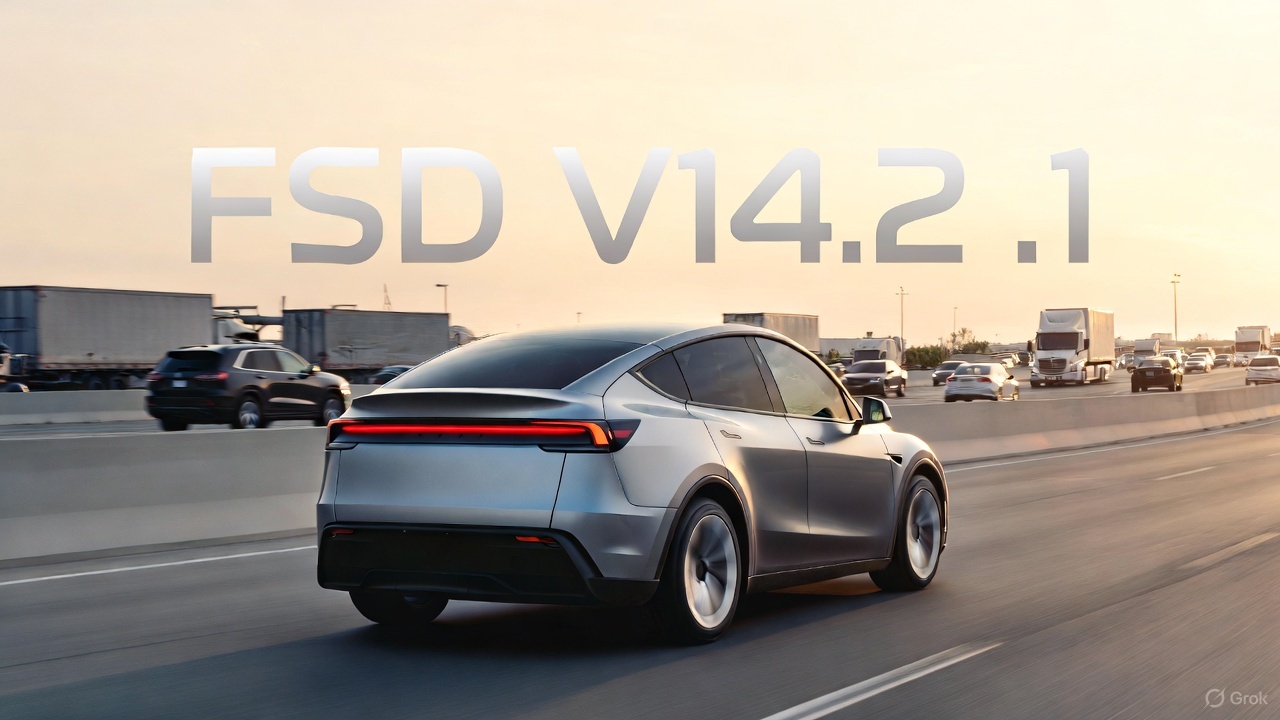
Tesla’s Full Self-Driving (Supervised) software continues its rapid evolution, with the latest V14.2.1 update drawing widespread praise for its smoother performance and smarter decision-making.
Videos and firsthand accounts from Tesla owners highlight V14.2.1 as an update that improves navigation responsiveness, sign recognition, and overall fluidity, among other things. Some drivers have even described it as “more alive than ever,” hinting at the system eventually feeling “sentient,” as Elon Musk has predicted.
FSD V14.2.1 first impressions
Early adopters are buzzing about how V14.2.1 feels less intrusive while staying vigilant. In a post shared on X, Tesla owner @LactoseLunatic described the update as a “huge leap forward,” adding that the system remains “incredibly assertive but still safe.”
Another Tesla driver, Devin Olsenn, who logged ~600 km on V14.2.1, reported no safety disengagements, with the car feeling “more alive than ever.” The Tesla owner noted that his wife now defaults to using FSD V14, as the system is already very smooth and refined.
Adverse weather and regulatory zones are testing grounds where V14.2.1 shines, at least according to testers in snow areas. Tesla watcher Sawyer Merritt shared a video of his first snowy drive on unplowed rural roads in New Hampshire, where FSD did great and erred on the side of caution. As per Merritt, FSD V14.2.1 was “extra cautious” but it performed well overall.
Sign recognition and freeway prowess
Sign recognition also seemed to show improvements with FSD V14.2.1. Longtime FSD tester Chuck Cook highlighted a clip from his upcoming first-impressions video, showcasing improved school zone behavior. “I think it read the signs better,” he observed, though in standard mode, it didn’t fully drop to 15 mph within the short timeframe. This nuance points to V14.2.1’s growing awareness of temporal rules, a step toward fewer false positives in dynamic environments.
FSD V14.2.1 also seems to excel in high-stress highway scenarios. Fellow FSD tester @BLKMDL3 posted a video of FSD V14.2.1 managing a multi-lane freeway closure due to a police chase-related accident. “Perfectly handles all lanes of the freeway merging into one,” the Tesla owner noted in his post on X.
FSD V14.2.1 was released on Thanksgiving, much to the pleasant surprise of Tesla owners. The update’s release notes are almost identical to the system’s previous iteration, save for one line item read, “Camera visibility can lead to increased attention monitoring sensitivity.”
News
Tesla FSD Supervised ride-alongs in Europe begin in Italy, France, and Germany
The program allows the public to hop in as a non-driving observer to witness FSD navigate urban streets firsthand.

Tesla has kicked off passenger ride-alongs for Full Self-Driving (Supervised) in Italy, France and Germany. The program allows the public to hop in as a non-driving observer to witness FSD navigate urban streets firsthand.
The program, detailed on Tesla’s event pages, arrives ahead of a potential early 2026 Dutch regulatory approval that could unlock a potential EU-wide rollout for FSD.
Hands-Off Demos
Tesla’s ride-along invites participants to “ride along in the passenger seat to experience how it handles real-world traffic & the most stressful parts of daily driving, making the roads safer for all,” as per the company’s announcement on X through its official Tesla Europe & Middle East account.
Sign-ups via localized pages offer free slots through December, with Tesla teams piloting vehicles through city streets, roundabouts and highways.
“Be one of the first to experience Full Self-Driving (Supervised) from the passenger seat. Our team will take you along as a passenger and show you how Full Self-Driving (Supervised) works under real-world road conditions,” Tesla wrote. “Discover how it reacts to live traffic and masters the most stressful parts of driving to make the roads safer for you and others. Come join us to learn how we are moving closer to a fully autonomous future.”
Building trust towards an FSD Unsupervised rollout
Tesla’s FSD (Supervised) ride-alongs could be an effective tool to build trust and get regular car buyers and commuters used to the idea of vehicles driving themselves. By seating riders shotgun, Tesla could provide participants with a front row seat to the bleeding edge of consumer-grade driverless systems.
FSD (Supervised) has already been rolled out to several countries, such as the United States, Canada, Australia, New Zealand, and partially in China. So far, FSD (Supervised) has been received positively by drivers, as it really makes driving tasks and long trips significantly easier and more pleasant.
FSD is a key safety feature as well, which became all too evident when a Tesla driving on FSD was hit by what seemed to be a meteorite in Australia. The vehicle moved safely despite the impact, though the same would likely not be true had the car been driven manually.
News
Swedish union rep pissed that Tesla is working around a postal blockade they started
Tesla Sweden is now using dozens of private residences as a way to obtain license plates for its vehicles.

Two years into their postal blockade, Swedish unions are outraged that Tesla is still able to provide its customers’ vehicles with valid plates through various clever workarounds.
Seko chairman Gabriella Lavecchia called it “embarrassing” that the world’s largest EV maker, owned by CEO Elon Musk, refuses to simply roll over and accept the unions’ demands.
Unions shocked Tesla won’t just roll over and surrender
The postal unions’ blockade began in November 2023 when Seko and IF Metall-linked unions stopped all mail to Tesla sites to force a collective agreement. License plates for Tesla vehicles instantly became the perfect pressure point, as noted in a Dagens Arbete report.
Tesla responded by implementing initiatives to work around the blockades. A recent investigation from Arbetet revealed that Tesla Sweden is now using dozens of private residences, including one employee’s parents’ house in Trångsund and a customer-relations staffer’s home in Vårby, as a way to obtain license plates for its vehicles.
Seko chairman Gabriella Lavecchia is not pleased that Tesla Sweden is working around the unions’ efforts yet again. “It is embarrassing that one of the world’s largest car companies, owned by one of the world’s richest people, has sunk this low,” she told the outlet. “Unfortunately, it is completely frivolous that such a large company conducts business in this way.”
Two years on and plates are still being received
The Swedish Transport Agency has confirmed Tesla is still using several different workarounds to overcome the unions’ blockades.
As noted by DA, Tesla Sweden previously used different addresses to receive its license plates. At one point, the electric vehicle maker used addresses for car care shops. Tesla Sweden reportedly used this strategy in Östermalm in Stockholm, as well as in Norrköping and Gothenburg.
Another strategy that Tesla Sweden reportedly implemented involved replacement plates being ordered by private individuals when vehicles change hands from Tesla to car buyers. There have also been cases where the police have reportedly issued temporary plates to Tesla vehicles.

